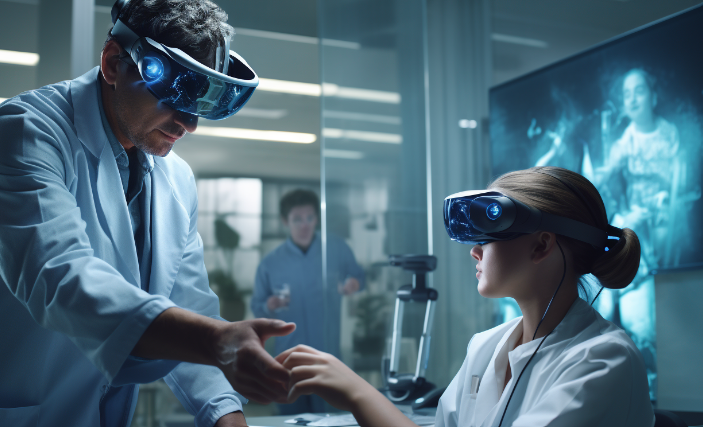The VR Healthcare Revolution: Exploring the Next Wave of Immersive Innovations
Virtual reality (VR) technology has been incorporated into the healthcare sector in recent years, revolutionizing the field. Virtual reality has demonstrated its potency in augmenting medical instruction, therapy, and patient care. VR has many useful and profound uses in healthcare, from pain management to surgical simulations. The VR applications that are revolutionizing the healthcare industry will be covered in-depth in this article.
- Pain Distraction and Management
Virtual reality has demonstrated enormous promise in diverting patients from severe discomfort during medical operations. Healthcare professionals can minimize the need for traditional pain management procedures by effectively reducing patients’ perceptions of pain through the use of virtual environments.
- Surgical Training and Simulation
Surgeons can receive training on a safe and affordable platform with VR-based surgical simulators. Surgeons can perform difficult procedures in an immersive environment, hone their abilities, and become acquainted with novel surgical techniques owing to these simulators.
- Phobia Treatment
Virtual reality has shown promise as a treatment for anxiety disorders and phobias. Therapists can help patients overcome their concerns by gradually acclimating them to virtual circumstances that trigger their phobias in a safe atmosphere.
- Physical Rehabilitation
VR technology is being applied to improve programs for physical rehabilitation. Patients can participate in engaging and stimulating activities that facilitate their recuperation from surgeries or accidents by use of interactive virtual reality workouts.
- Medical Education
VR is transforming medical education by offering immersive learning experiences for students and professionals. From exploring 3D anatomical models to interactive medical case simulations, VR is revolutionizing the way medical knowledge is imparted and retained.
- Stress Reduction
- Healthcare settings can be stressful for both patients and medical staff. VR technology provides a tool for relaxation and stress reduction through immersive relaxation experiences and mindfulness exercises.
- Telemedicine and Remote Consultations
- By building realistic virtual worlds that allow patients and healthcare providers to interact and communicate in real-time, virtual reality (VR) is enabling telehealth and remote consultations by removing the boundaries of physical distance.
Conclusion
- The mentioned uses of VR in healthcare only scratch the surface of its enormous promise. VR technology has the potential to revolutionize therapy, medical education, and patient care as it develops. Healthcare practitioners may transform the way healthcare is provided, improve patient outcomes, and raise the standard of care by adopting these immersive innovations.
- We must keep up with these advancements as thought leaders in the B2B market and look for ways to incorporate VR technologies into healthcare goods and services. Through the utilization of immersive innovations, business-to-business (B2B) organizations can significantly influence the direction of healthcare delivery and promote patient-centred care.


